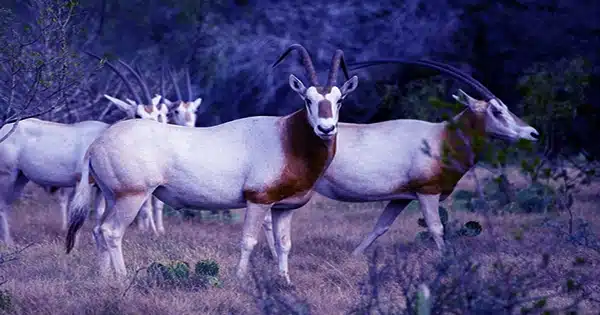The scimitar-horned oryx (Oryx damage), an antelope species previously considered extinct in the wild by the IUCN, has been downgraded to Endangered. Conservation attempts to safeguard various animal species typically adopt one of two approaches: ex-situ, in which the animal is cared for away from its natural environment, or in-situ, in which the animal is cared for in its native home or surrounding ecosystem. This species’ status has shifted as a direct result of both types of conservation initiatives.
The scimitar-horned oryx is a big antelope adapted to desert life. The species name comes from its exquisite horns, which are bent like a scimitar blade. Previously, these antelope were found throughout North Africa; however, protracted droughts and poaching for their horns and meat in the 1980s decimated the population. The species was declared extinct in the wild in 2000, and it has since only lived in captive collections around the world.
Fortunately, a major recovery project began in 1985 with partners including ZSL London Zoo and the Sahara Conservation Fund (SCF). The investigation used an in-depth approach to determine whether a hypothetical reintroduction program could succeed in the future. Surveys were done in 2009 and 2013 to identify potential locations for reintroduction, including Chad’s Ouadi Rimé-Ouadi Achim Game Reserve.

“All Saharan antelope species are severely threatened, but this project is proof that with the right will and resources, we can secure a future for them all.”
In 2016, 21 scimitar-horned oryx were released into the wild in Chad in a safe fenced area, each with a GPS satellite collar to allow experts to track them. The crew was ecstatic when, some six months after its release, the first scimitar-horned oryx calf in almost 30 years was born in the wild. The following year, in January 2017, 14 additional oryx were released into the same location.
The project’s purpose has always been to develop a healthy, self-sufficient population. Since the oryx was released back into Chad, 510 calves have been born in the wild.
The publication of a research article in the journal Science examining 95 species of plants and animals that have all been declared extinct in the wild but have been cared for in captivity by humans since 1950, including the oryx, combined with the population in Chad, has resulted in the species being downlisted from extinct to endangered.
“The status change of scimitar-horned oryx from Extinct in the Wild to Endangered is a testament to the power of collaborative conservation action, and it gives us all hope that we can make a real difference and restore nature,” said Dr. Tania Gilbert, Head of Conservation Science at Marwell Wildlife. “The species is still at risk from extinction (Endangered), but the conservation work in Chad, Tunisia, Morocco, and Senegal greatly reduces this risk and has given the species a real chance of recovery.”
According to the report, just one-fourth of the current Extinct Wild species have been included in a reestablishment program, but the project’s success demonstrates that reintroduction projects can succeed with international cooperation and conservation efforts from numerous groups.
“Projects like the Scimitar-horned oryx show that reversing the fate of these species is possible; we just need to be able to give the same resource and commitment to the other Extinct in the Wild species that survive only under human care,” said Professor John Ewen, a researcher at ZSL’s Institute of Zoology and senior author of ZSL’s Extinct in the Wild study.















